originally posted at https://canmom.tumblr.com/post/684941...
Hello friends. We are here once again.
Earlier this week, I received the worst news imaginable about the death of my friend Fall Rose. It has not gotten any easier. I have just finished creating the first version of a kind of digital shrine to hold our memories of her. Please contact me if you’d like to add anything to this; I would like it to hold as much of our love for her as it possibly can.
When we’re all ready, we will do more to commemorate her - perhaps hold some kind of ceremony, I don’t know what kind. Fall’s friends all live so far apart. But for now, for my sake, I want to revisit one of my fondest memories with her: the time we watched Haibane Renmei.

Just over a year ago, we got together with @mogsk and @schizsune and L. for our weekly anime ‘book club’ and Fall picked her favourite anime to share with us. So I will let her introduce it in her own words:
i guess it’s about time i announce the anime i have selected for this week! >:D
it is my favorite one ever, Haibane Renmei (灰羽連盟) which could be translated as Charcoal Feather Federation. it’s about the haibane, young people born fully formed into a mysterious, isolated, walled city, remembering nothing of who they are but a dream from inside their cocoon. they live among humans in this city as sort of second class citizens, central to everything about it yet excluded from most dwellings, jobs, or even carrying money
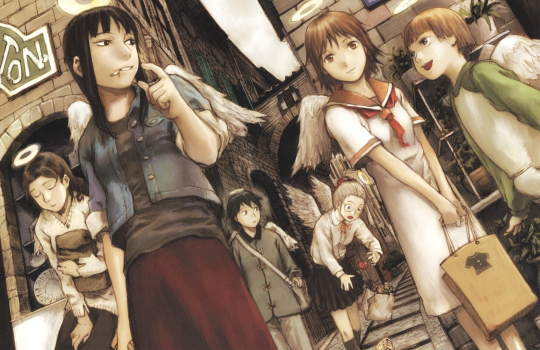
in particular it focuses on the relationship between two haibane and their struggle with feelings they can’t tell anyone about, people they’ve hurt, horrible things they can’t remember
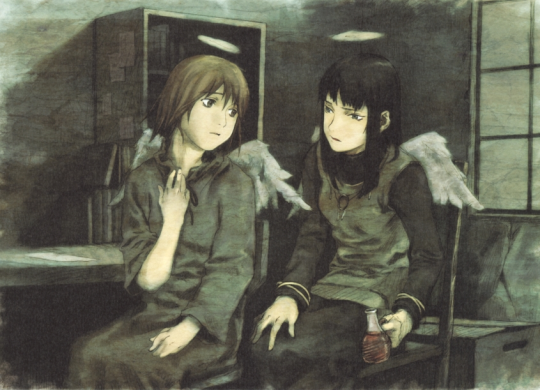
Rakka and Reki
despite the christian imagery, most of the religious themes are very buddhist
revealing too much of its themes could get spoilery but largely it’s about like, the connections between people, depression, self-harm, the nature of life and existence
but overall it’s not a like, gloomy anime, very slice-of-lifey in many aspects
this fansite has a lot of interesting information, especially on the message board, and it all still seems to be up! https://cff.ssw.net/index.htm
also before making the anime Yoshitoshi Abe did a little doujinshi with the same idea!
the series is thirteen episodes, with the first half being more light-hearted, getting to know the setting, and the emotional stuff mostly coming in the second half
Fall’s introduction is perfect, but please let me fill in a little more, to add a little sakuga-y context as is my wont~
You may well recognise the distinctive flavour of the character designs here. Yoshitoshi ABe (安倍 吉俊, but he tends to use the romaji instead so that he can include the AB initials) is of course the character designer for the renowned Serial Experiments Lain (1998). ABe began making art by drawing graffiti during his teens in Tokyo, often facing trouble with the law, and while I do not know the details of this time, it coloured much of his later work.
In 1994 he first took his art to manga magazines and dōjinishi, beginning with Ame no Furu Basho in the seinen magazine Montly Afternoon, followed by the dōjin Furumachi in 1996. You can see scanlations of some of his works here on Mangadex. The earliest form of Haibane Renmei is in fact an art book. Here is his preface; I’m not sure who the translator is:
This time it’s a book about angels. I started off with nothing more than a simple notion of increasing the variety of girls I draw. As a result they give off the impression of being bungling, rather un-angelic creatures, and to go along with that theme, their wings are gray as well. They do not possess any strange powers, naturally. And no, they can’t fly. They aren’t of any help to others, and they don’t do the world any great services either. What a letdown. But personally I feel that is what makes them attractive. What do you think?
What I really wanted to do was practice drawing middle-aged men and women, and had decided “alright, this winter I’m making a Moms and Pops book!”
But alas, I lost out to the temptation that “if I can’t fill all the pages, I can just stick wings and halos on some old rejected drawings and voila, angels!” And so my course of action was changed. I apologize to all of you out there who are fans of middle-aged people.
I also apologize for this book being so thin.
Despite this self-effacing introduction, the book is full of cute pictures playing on the premise…

ABe’s figures are deceptively simple. He keeps his face profiles down to just a few lines, abstracts away most of the features, and pushes their proportions towards a circle no matter the angle, but this all serves to help create a unique mood - one hard to put into words, but perhaps, forlorn, vulnerable.
He got his break into anime in the same year, with the invitation to design characters for the groundbreaking psychological cyberpunk series Serial Experiments Lain. I will certainly write a great deal more about Lain in the future, but let’s at least set some context.
In the late 90s and 2000s, anime was going through the troubled transition to digital compositing, and yet this was also a period with an enormous flourishing of experimental work. Japan was still in the depth of its “lost decades”, with the buoyant excitement of the 80s bubble economy a distant memory.
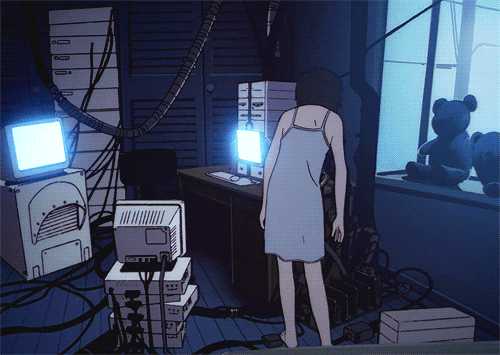
To walk back a bit, the 90s saw, in one strand, an increasing turn towards heavier, psychological subjects - exemplified of course by Neon Genesis Evangelion (Animation Night 18, see also Matteo Watzky’s excellent article on Eva in context) and the rise of Mamoru Oshii and Headgear with films like Patlabor 2 (1993) and Ghost in the Shell (1995) (AN 38 + once again, see Watzky), Satoshi Kon with films like Perfect Blue (1997) (Animation Night 16, 42) and Isao Takahata continuing his own strand with Only Yesterday (1991) and Pom Poko (1994).
For this kind of 90s anime, desaturated palettes, slowed down pacing, detailed observation of relatively everyday scenes, and a general sense of ambiguity and even ennui were important. Of course, this was not the whole of 90s anime; it spans a spectrum to e.g. Slayers! And even in the works listed, not all of them were as dry as Oshii. But I definitely feel in the most influential works, a more sombre tone took hold.
Lain pushed this even further at the tail end of this wave, and set the tone for the stranger works of the new digital era: risky and experimental, with an entirely unconventional story and oblique symbolism that requires many watches to fully appreciate. Please take the time at some point to read on some of its influences; I do not have time to do them justice here.
Anime character designers tend to almost always be experienced key animators and animation directors, and they have a profound influence on the eventual look and feel of a show. Yoshitoshi ABe was not of this mold; he was a highly independent dōjinishi creator; his designs for Lain were a co-creation with many other members of the team. Nevertheless, he proved a perfect fit; the style of his figures and the hint of an expansive inner world gives a lot of weight to even the most static scenes.

In the wake of Lain, ABe continued to make dōjinishi projects with his circle, Mutekei Romance. He first created the series NieA_7 (mangadex), about a cram school student living with an alien; it carries many of the same themes, combining humour and melancholy.
ABe would then return to the Haibane Renmei concept in 2001, with a new dōjinishi, this time not just an art book but a full manga. Here, the major concepts of the series came together properly: the setting of ‘Old Home’ and its adjacent town, Rakka and Reki, the Haibane breaking from an egg to arrive in Old Home. The series has a beautiful range of pencil-y midtones and texture.
In fact this manga ended up running for only two issues, since ABe was approached by Radix Ace Entertainment, a short-lived anime studio founded in 1995, which would be dissolved just a few years later in 2006. There is unfortunately not a lot of information about Radix Ace out there; Haibane Renmei appears to be by far their best known work.
So, of the staff who worked on Haibane Renmei, the one who stands out most to me is key animator Norio Matsumoto. He’s known for his work on Naruto where he would animate flashy combat cuts like this one, but he’s got a ton of range, having for example a wonderfully characterful cut in the Stink Bomb on Memories. You can see some of the cuts he created on Sakugabooru; his scenes have a distinctive sense of solidity, with actions flowing into each other naturally, and careful attention paid to the weight of things like hair - all regardless of a limited drawing count.

Here’s the full scene this Matsumoto cut is taken from. He also excels at scenes of intense emotion, something vital for a series like this.
Matsumoto has the most credited cuts, but that isn’t many. Another standout comes from Takahiro Kishida, a veteran of Lain, who drew the climactic scene in which Rakka saves Reki from being consumed by her darkest memory, creating the powerful image of a slimy ghost train bursting into the real world. Tokuyuki Matsutake, another Naruto veteran as well as animator on Ranma ½, created the now all too painful scene of Rakka mourning her friend who suddenly disappeared on her ‘Day of Flight’, and on the opposite end, the charming scene of Rakka being given her halo.
ABe was not experienced in animation, so while I don’t know how responsibilities broke down exactly, the work of making his vision into something viable to animate would have gone to series director Tomokazu Tokoro, who had previously worked on Lain and would once again direct a ABe series later when adapting NieA_7. Tokoro had a long experience going back to the late OVA era, including Lupin III: Island of Assassins, and the cyberpunk Armitage III (1995). But his other major credit might surprise you - the utterly absurd and bombastic Hellsing Ultimate, in which Nazi vampires with absurd accents give hilariously overwrought speeches before the protagonists bloodily slaughter them. (It’s a stupid sort of fun - I’ve actually only seen the English dub, years ago, but the accents add a lot.)
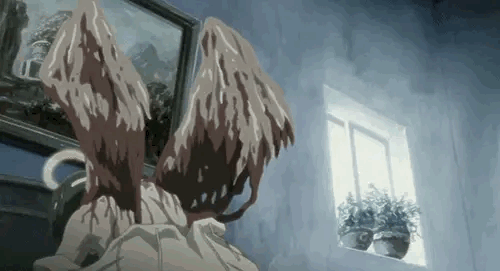
Unlike all of these more action-oriented projects, Haibane Renmei is slow, gentle, and quietly devastating. As Fall wrote, it begins as mostly a slice of life series, in which we follow the cute antics of Rakka as she gets acquainted with life as a Haibane. But the turning point comes when her sweet friend Kuu gradually withdraws from life, and then disappears. Rakka learns, painfully, that each Haibane is waiting to take their ‘day of flight’ in which they move on from the strange realm that Old Home represents into an unknown afterlife.
Consumed by grief, Rakka becomes ‘sin-bound’, with her feathers starting to turn black. She tries to hide it by cutting off the feathers - and she learns that the seemingly distant and aloof Reki, like her, is trapped by the weight of her past, also unable to take her Day of Flight. Rakka becomes increasingly concerned with trying to help Reki move on, and through her efforts, is drawn to make contact with the wall and glimpse some of the still-vague mysteries. In so doing, she comes into the hands of the the ‘Toga’, the mysterious and aloof masked figures who oversee the Haibane.
Much of the broader setting is left deliberately vague. We never discover why the Haibane are reborn from their eggs here, where they go, who the Toga are, or anything like that. It’s important that we don’t, for the metaphor to work. And I’m sure that, with my limited knowledge of Buddhism, I am missing a lot of what is implied. All the same, the emotional meaning comes through with perfect clarity.
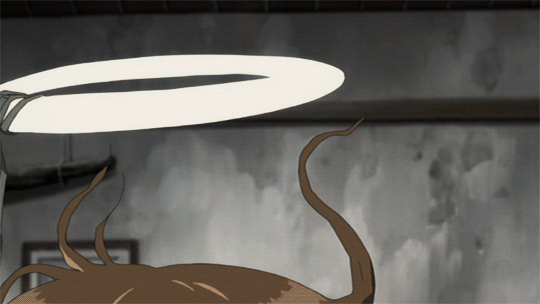
And of course, it would be wrong to talk about merely animation; a huge amount of credit must also go the soundtrack of Kou Otani and Heart of Air (Masumi Ito). Using mostly Western classical instruments like pianos and violins and even harmonicas, the music perfectly captures the tone of the series - whether gentle and upbeat or powerfully moving. The ED, with Ito’s vocals, is especially haunting.
(At this point, I should make a shoutout to the blog @haibanerenmei, which has for years been posting stills, production materials, etc. I know Fall subscribed to them, and I’m sure she was glad to see her favourite anime so well appreciated.)
It is a beautiful work; there is nothing else quite like it. I am so glad that it could touch Fall’s life and bring her such joy. So please: join me at https://twitch.tv/canmom, where tonight we will watch as much of it as we can, perhaps the whole thing, and if not, then I will play the rest once I’m back in London this weekend. We’ll watch it, we’ll talk about Fall, and I hope in this way we can remember her well, and cry the tears we need to.
Thank you so much everyone who joined me for the first half of Haibane Renmei. Tonight we’ll watch the remainder.
What struck me on watching it again was just how well the show handles grief. It was… eerie how resonant it was (and devastating, but in, I feel, a necessary way). The initial uncertainty, when the characters do not yet know what has become of Kuu, giving way to horror and disbelief as they go to investigate. The sense of disconnection we experience through Rakka, as the rest of the world carries on, oblivious to the overwhelming tragedy.
Even specific events are familiar; the relief of the Haibane boy from the Abandoned Factory when he learns that Reki was not the one to depart, and the pain his careless ‘good.’ inflicts on Rakka. (Nobody was so callous with me, but I did manage to make someone think a different person had died, and I could sense their conflicted relief when they found out it was a stranger.)
It is not uncommon in sff for characters to be motivated by grief, often driving them to terrible ends: forbidden alchemy, revenge, even the Human Instrumentality Project… These stories have enormous value, but there is something altogether more devastating about Haibane Renmei’s subtler approach. Rakka will never get Kuu back; she is unable to move on but there is no project for her to throw herself into. She just quietly goes along. Right after the brief time skip, we immediately meet her speaking to Kuu in the window. (I have been doing something like this, writing Discord messages that Fall will never read).
Rakka self-isolates in her grief; she cleans Kuu’s empty room, eats alone, tortures herself with the memory, represented viscerally by the appearance of black splotches on her feathers, which she cuts off to try to hide. Reki is the one who sees this and understands and is therefore able to support her, because she shares a similar experience; both are trapped by this grief, yet Reki promises Rakka that Rakka will get out of it, because unlike Reki she is a ‘good Haibane’. And eventually, at the end of the last episode we watched, Rakka is drawn away from society by the birds from her dream in the cocoon; there she finds a fallen bird (implicitly, a friend from her past life) at the bottom of a dry well, and buries it, and at the same time lays Kuu to rest in her mind, before passing out. This simple, ‘pointless’ act is the start of her arc of rebuilding, in which she will get invested in helping Reki. The ‘Day of Flight’ can become, for Rakka, not a symbol of death and a friend being suddenly torn away, but something she can accept.
We hear something of this already. Shortly before she leaves, Kuu speaks of the ‘drops’ filling a ‘pretty, clear cup’ in her mind; thanks Rakka for providing some. (Rakka doesn’t understand, at this point, and is left staring out the window, lost in thought.) You can imagine, when I reached this point, how much I was crying. It is implicit that the Haibane are all recovering from some trauma in their past lives before being reborn in this village; that through the gentleness of their friends and the simple work they perform in the village, they can move on. But of course, the show’s real concern is those for whom it doesn’t come that easily. Rakka, and especially Reki, are being punished by this system for the kindest and most understandable emotions. (One theme that has recurred in a lot of Buddhist-inflected fiction I’ve read is the cruelty of this demand to let go of attachments.)
Fall felt very strongly that she was shadowed by an inescapable past. She thought terrible things of her past self; things that honestly seem very unlikely to be true or fair accounts, given how easily she imagined harm in her most innocuous actions, but they were painfully real to her. No wonder, then, that she saw herself in the Haibane. This is why I talk so much of her finding a kind of peace at the end. It try to think that I was one source of the drops that filled her cup, rather than that I failed to find the right way to help her.
So all I can say is that, even had Fall not loved Haibane Renmei, it would have been the mirror I needed to see. I’m grateful, because to tell a story like this, I can only imagine that ABe lost someone dear to him too. Perhaps we can see a little of that person’s ‘spirit’ or ‘inner law’, in another friend’s words, reflected in our Haibane.
I wish we could have discussed it in depth. But there is this. I’m sure I still have tears that need crying.
Comments